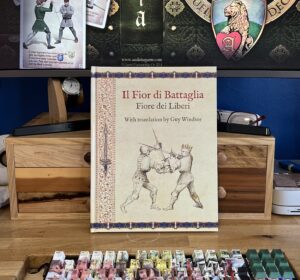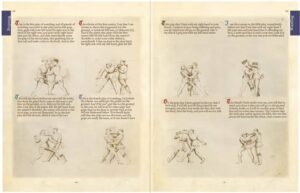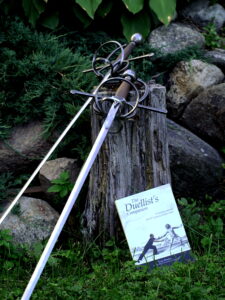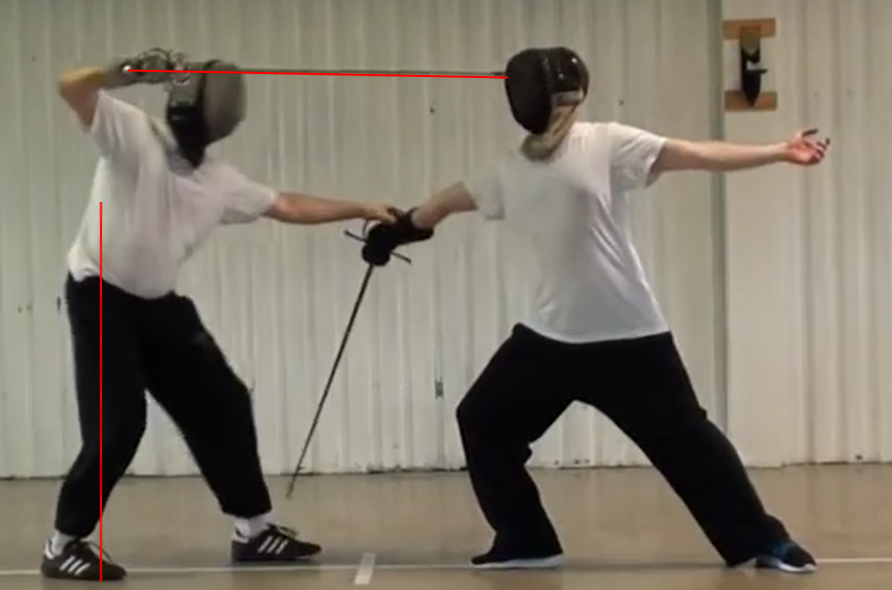The Prudentia virtue, from the Audatia Duel Deck Nikodemus Kariensis.
There are few things that all martial artists agree on, but I think this may be one of them: “it’s easier to fight someone if you know exactly what they are going to do”. To predict their actions. To see the future. This skill is one of the aspects that marks an experienced fighter in any discipline. They can read their opponent and see what they are about to do; but also they can create the situation so that the opponent is lead into a trap. Fiore de’ Liberi knew about this perfectly well back in the 14th century: it’s one of the four virtues he says a swordsman should possess. Avvisamento (foresight) in the Getty ms, Prudentia (prudence) in the Pisani-Dossi and the Paris mss. For what is prudence if not the ability to foresee danger and avoid it?
Meglio de mi lovo cervero non vede creatura
Eaquello mette sempre a sesto e a misura.
No creature sees better than I, the lynx
And this virtue puts everything in its right place and its measure. (Tr. Tom Leoni)
Foresight is a virtue and a skill, and it can and should be trained. As you probably guessed, I have a well-developed system for doing exactly that. It relies as always on starting very simple, and gradually increasing complexity, while always focussing precisely on the one thing you’re working on. Because the virtue is first discussed in fencing literature in Il Fior di Battaglia, it makes sense to use longsword for my example, but you should be able to apply this to any martial art. This is the bare bones of the three-step process.
Step one: establish the base
1) Set up a basic drill. We’ll use first drill as an example:
https://youtu.be/1Dc9s21EDkI
2) Set up a simple variation, ideally with the defender responding differently: such as a counterattack, rather than a parry. (Such as in the Stretto form of first drill).
https://youtu.be/99H94CzB1Ik
3) The attacker’s job is to counter the defence; either parry the counterattack, or strike on the other side of the parry (as here in our set drills).
At this stage the attacker is just watching the defender, and the defender is just feeding the attacker one defence then the other. No variations. Ok, we have established our base.
Step two: create controlled complexity.
1) The defender now varies their defence, so that the attacker doesn’t know which one he will pick.
2) The attacker’s job is to predict the defence. If she counters it, then great, that’s a bonus. But we’re working on the skill of foresight, not the application of that skill. The attacker makes five attacks, and counts how many times she accurately predicted which of the two things the defender would do.
3) Change roles, 5 attacks, 5 defences. Try to be as random as possible.
4) Use the rule of c’s* to adjust the level of the drill so that the attacker has difficulty predicting the defence.
In a perfect world, you can always predict exactly what your opponent will do, and set things up so that if he does anything else, it will fail naturally, and if he does what you expect, he falls onto your prepared counter.
Step three: reduce their options
1) The attacker adjusts her attack so that the counterattack will naturally fail. In this example, that means aiming the mandritto fendente slightly further over to the left, and stepping slightly across the strada to the attacker’s left. There is no hole to counterattack into. So the defender either parries, or their action will fail.
2) The attacker adjusts her attack to invite the counterattack, by swinging the mandritto fendente round, offline a bit to the right. If the invitation is accepted, the attacker parries the counterattack; if it is declined, and the defender parries, their parry will be wider than usual, making the attacker’s counter much easier.
3) To start with, exaggerate these adjustments to the attack, and co-operate in the responses. Once the idea is clear in both player’s minds, they should ramp it up a bit.
4) Once this is going well, the attacker’s job becomes simply to predict the defender’s actions, and the defender’s job is to respond naturally to the attack with one of the two options. As before, use the rule of c’s to adjust the level of difficulty until the attacker is getting it right about four times out of five.
And finally: add complexity
So far so good. We have a drill in which there is only one degree of freedom; the defender’s action. Everything else is set; the roles of attacker and defender, the attack, the two defences, everything. So now apply the variation engines: “who moves first”, “add a step”, and “degrees of freedom” that you know from Preparing for Freeplay or The Medieval Longsword, to add complexity to the point where the attacker can only get it right three or four times out of five. This might be as simple as step three above, or as complex as full-on freeplay.
Be very clear about what you are training: if you are working on foresight, success = “I predicted exactly what they would do”. It doesn’t matter if you got hit or not. Of course, as your foresight improves, not getting hit should be a lot easier than before.
One more thing:
As you probably know, Audatia is based on Fiore's art. And it totally killed me that we couldn't have Prudentia being used to make the opponent show their hand. The closest we come to that is in this brilliant card, Eye of the Lynx, in the Boucicault deck:
*The rule of c’s is in The Medieval Longsword, and Preparing for Freeplay, and written out in this blog post here.
 You can find the facsimile here, and the companion volume here.
You can find the facsimile here, and the companion volume here.






